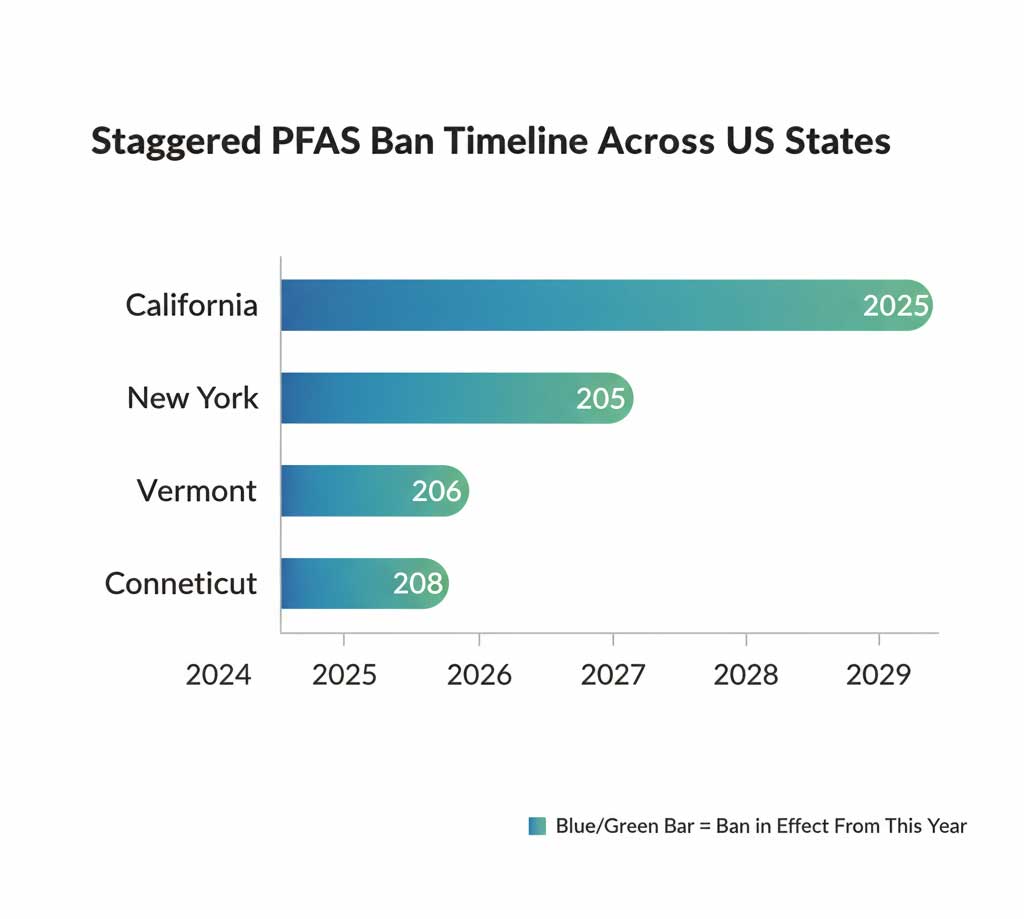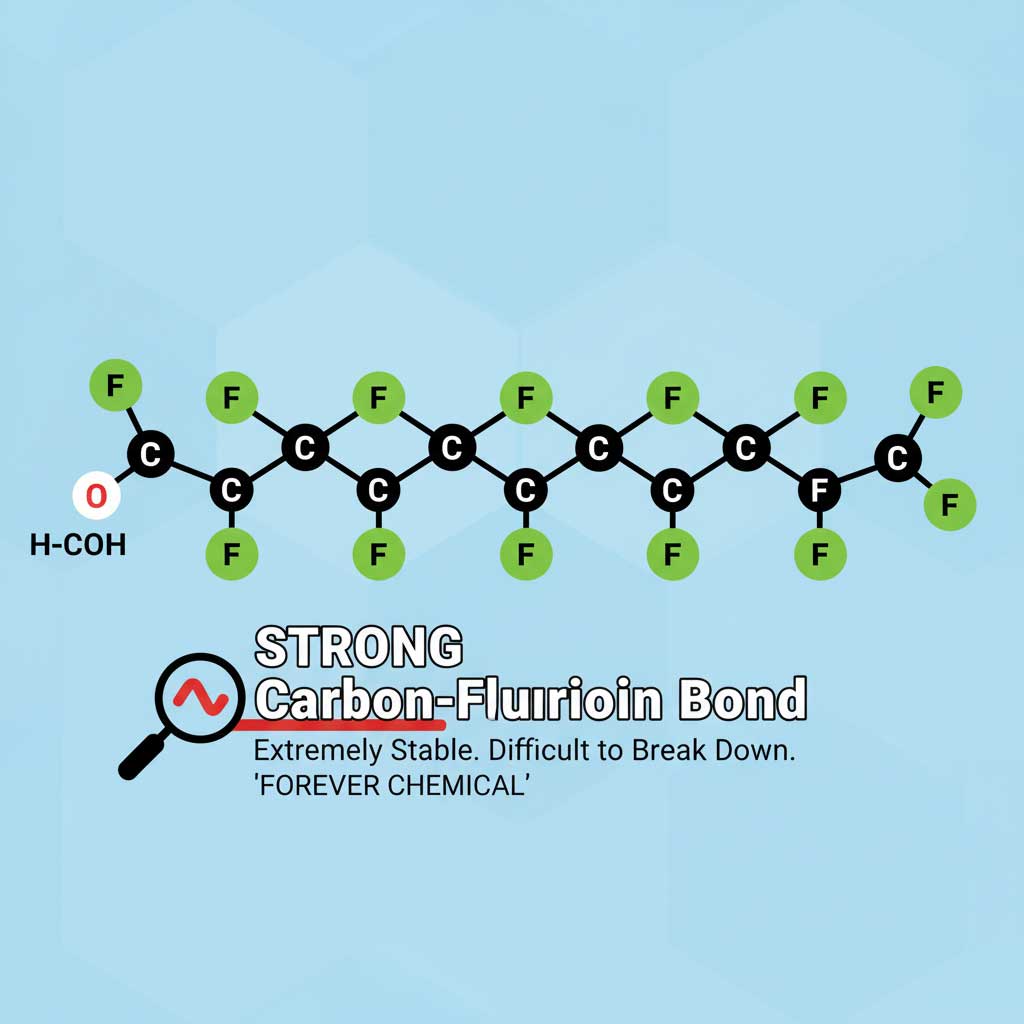Safety First: Navigating the 2025 PFAS Chemical Regulations in Waterproof Outdoor Clothing
1. Introduction & The Verdict
Key Takeaway: The era of PFAS chemicals (or “forever chemicals“) in standard outdoor apparel is officially over. Beginning January 1, 2025, major US markets (California and New York) [1] prohibit the sale of new clothing items with intentionally added PFAS for functional effects.[2, 3, 4] This means your new raincoat or ski jacket will be safer for you and the planet, but *you* must prioritize jacket maintenance to ensure performance.
Product Context: What are PFAS?
PFAS (Per- and polyfluoroalkyl substances) [5] are a group of thousands of human-made compounds used in clothing and textile products since the 1950s because they are excellent at repelling water, oil, and stains. They are often called “forever chemicals” because the strong carbon-fluorine bond prevents them from breaking down easily in the environment, contaminating drinking water, soil, and wildlife for hundreds of years.[6, 3] The mounting concern over pfas exposure, linked to health or environmental hazards like immune system disorders and certain cancer risks, prompted these new state laws.[7, 6]
Target Audience: The Concerned Consumer
This regulatory shift impacts everyone who buys new apparel or outdoor gear, from casual hikers to serious mountaineers. If you are concerned about your personal health, the environmental hazards of your gear, or just want to ensure your waterproof jacket actually works in the rain, this guide is for you.
2. Regulation Overview & Technical Specs: The 2025 PFAS Ban
Key Specifications: The January 1, 2025 Deadline
Several US states, most notably New York and California, have implemented comprehensive restrictions on PFAS in apparel.[4, 3]
The core of the new regulation is simple: starting beginning January 1, 2025, companies cannot manufacture, distribute, or offer for sale apparel containing perfluoroalkyl and polyfluoroalkyl substances as intentionally added chemicals within those states.[4, 6]
- Intentionally Added PFAS: This refers to the pfas chemicals added specifically to enhance the waterproofing or stain-resistance of the textile. This is defined as a chemical product that serves an intended function or technical effect in the product.[4]
- Apparel Covered: This includes a broad range of clothing items like shirts, pants, skirts, dresses, overalls, bodysuits, vests, dancewear, suits, saris, scarves, tops, leggings, leisurewear, formal wear, onesies, bibs, and diapers.[4]
The Exemption for Extreme Conditions
There is a critical, temporary exemption for outdoor apparel for severe wet conditions, such as gear used for offshore fishing or mountaineering.[4, 6]
- Temporary Exemption: This highly specialized apparel designed for severe wet conditions can still contain intentionally added PFAS until 2028 (in California) or later (in other states).[3]
- Mandatory Disclosure: However, as of January 1, 2025, if this extreme-condition outdoor apparel with intentionally added PFAS is sold, it *must* include a clear disclosure label stating, “Made with PFAS chemicals”.[3]
3. The New ‘Design’: PFAS-Free DWR and Sustainability
Materials and Construction: The DWR Coating
For decades, the standard way to make a fabric repel water was to apply a DWR (Durable Water Repellent) coating using PFAS.[7] Now, brands must pivot to PFAS-free DWR alternatives.[8, 9]
- DWR Function: DWR is a topical chemical coating applied to the outer textile of a garment. It works by coating individual fibers, causing water to bead up and slide off, thereby preventing the fabric from getting saturated. Crucially, a good DWR does not affect breathability.[10, 11]
- Visual Appeal: The new apparel looks and feels the same, but they rely on different, safer polymer compounds than their “forever chemicals” predecessors.
4. Efficacy and Safety Analysis: The New Waterproofing
4.1 Core Functionality: Water Repellency and Maintenance
Modern PFAS-free alternatives can match the initial performance of old-school PFAS coatings. However, the new DWR is more vulnerable to degradation.[12] Dirt, grime, and oils from your body or the environment can affect the performance of DWR, causing the fabric to “wet out” (soak through).
Personal Story: As an outdoor enthusiast, I noticed that my post-2025 PFAS-free ski jacket started soaking up water after just one full season. I realized the secret wasn’t the jacket, it was my need to frequently clean and re-treat the PFAS-free DWR with a specialty wash-in product. The performance is there, but the maintenance is non-negotiable.
4.2 Safety Gaps: The Regulatory Timeline
The PFAS bans are rolling out in phases, which can be confusing. The key is knowing which regulations take effect now and which are coming later:
| State/Region | PFAS in Apparel Ban | Outdoor Apparel for Severe Wet Exemption |
|---|---|---|
| New York | Beginning January 1, 2025 (for intentionally added PFAS) [2] | Exempted, unless marketed for general consumer use [4] |
| California | Beginning January 1, 2025 (for intentionally added PFAS) [3] | Exempted until 2028, but requires “Made with PFAS chemicals” disclosure now [3] |
| Denmark | July 1, 2026 (Total fluorine limit of 50 ppm) [13] | None listed in initial ban |
| Connecticut | January 1, 2028 (all PFAS in textiles) [14] | None listed |
5. User Experience: Maintenance and Care
Daily Usage: What it’s like to use PFAS-Free Gear
The main difference in the user experience is that you become an active partner in maintaining the garment’s performance. The new DWR needs to be clean to work effectively. If rain stops beading up, the garment’s breathability will be affected, and you’ll feel damp.[10]
- Cleaning is Key: Washing away dirt and oils is the first step in restoring DWR’s water-shedding abilities. Use a technical fabric cleaner, not regular detergent.[10]
- Reapplication is Necessary: DWR wears off due to abrasion from rocks or washing. If cleaning and heat don’t revive it, you must reapply a new DWR coating using a spray-on or wash-in product that serves an intended function.[10]
6. Comparative Analysis: Brand Transition
Direct Competitors: Pioneers vs. Laggards
Some brands, recognizing the health or environmental hazards of forever chemicals, have already completed their transition, while others are being dragged by the ban.[15]
- Pioneers: Brands like Páramo and Finisterre use no PFAS in their products, and others like Fjällräven and Patagonia are mostly PFAS-free.[15]
- Laggards: A mid-2024 analysis found that over 80% of outdoor clothing companies were still using PFAS.[15] For these companies, the New York and California PFAS bans force a massive, rapid overhaul of their supply chain to ensure compliance.[3]
7. Pros and Cons of the Ban
What We Loved (The Benefits)
- Reduced Health Risk: Eliminating PFAS reduces pfas exposure for consumers and manufacturing workers.[7]
- Environmental Protection: Fewer forever chemicals contaminate drinking water, soil, and the natural environment.[3]
- Innovation: The ban forces the industry to find better, safer PFAS-free alternatives.[7]
Areas for Improvement (Challenges)
- Consumer Confusion: The staggered PFAS bans (e.g., California and New York in 2025, other states later) can confuse consumers about what is or is not allowed.[3]
- Maintenance Burden: Consumers must learn the new routine of cleaning and reapplying DWR to maintain waterproofing performance.[10]
- Exclusions: The exemption for personal protective equipment (like firefighter gear) remains, despite the historical use of PFAS in firefighting foam.[4]
8. Evolution & Future Roadmap
Improvements from Previous Versions: Beyond PFOA
The regulatory focus has moved beyond the original PFOA (Perfluorooctanoic acid) compounds, which are known to cause health risks, to the entire class of PFAS. This change means that substitute chemicals, which were sometimes just slightly modified PFAS, are now also being restricted.[16]
Future Roadmap: Total Elimination
The trend is toward the eliminating PFAS entirely. States like Minnesota are aiming to restrict all unavoidable PFAS uses by January 1, 2032.[9] Meanwhile, litigation related to sustainability claims and forever chemicals is expected to increase dramatically post-2025.[2]
9. Purchase Recommendations
Best For: Safety-Conscious Consumers
Buy new apparel marked with “PFAS-free DWR” or those from companies known to have phase out PFAS completely.[17]
Skip If: You Want to Set It and Forget It
If you are not willing to perform the recommended cleaning and re-treating of your jacket at home, the new PFAS-free jackets may disappoint you, as their DWR requires regular care to maintain optimal water resistance.[10]
Looking for high-performance sustainable fabrics? See our list of Conscious Fashion Brands.
Alternatives to Consider: The Physical Barrier
The single best alternative is to choose gear from brands that were already PFAS-free pioneers (e.g., Páramo).[17]
10. Where to Find Resources
- Retailer Check: Look for clear labels from the retailer that confirm compliance with the New York and California laws. The burden is on the brand to ensure compliance.[3]
- NGOs: Resources like the New York State Department of Environmental Conservation (NYSDEC) [18] can help you identify where PFAS are used and which brands are offering better products.[9]
11. Final Verdict
Overall Rating: 5/5 (A Necessary, Positive, but Nuanced Change)
Summary: The 2025 PFAS chemical regulations represent a landmark victory for consumer safety and environmental health. The ban on intentionally added PFAS in general apparel takes effect now in key markets, making your outdoor apparel safer. However, this shift places a greater responsibility on the consumer to understand that PFAS-free waterproofing requires proactive maintenance (cleaning and re-treating the DWR coating) to sustain its performance, especially in severe wet conditions.[10]
Bottom Line: Buy new gear confidently, knowing the law is protecting you. Choose brands committed to the PFAS ban and commit to treating your DWR coating yearly. Safety and performance are now linked to your care routine.
12. Evidence & Proof

Data/Measurements: Chart synthesizing the regulatory PFAS bans timeline across multiple US states, illustrating the staggered deadlines for eliminating PFAS in textiles.[19, 3, 9]
Video Embed: Tutorial demonstrating how to properly clean and reapply a new DWR coating to a PFAS-free outdoor gear jacket using a wash-in or spray-on product.[10]
Interactive Element: Simulated list of certified PFAS-free DWR suppliers (Dimpora, Green Theme Technologies) and outdoor apparel brands like Patagonia and Finisterre who are leading the way in removing PFAS from their supply chain.[9, 17]

Photos: Illustrative image of a PFAS molecule, visually representing the chemical structure that makes these compounds so persistent and difficult to break down.[3, 7]
Appendix: Source Citations
- [17] The Guardian. Outdoor clothing brands still using ‘forever chemicals’ despite health risk.
- [5] bluesign. PFAS in clothing: What you need to know.
- [9] Green Science Policy Institute. PFAS in Outdoor Gear (CT/MN regulations).
- [4] Pillsbury Law. New York and California Restrictions on PFAS in Apparel (NY Definitions).
- [2] Pillsbury Law. New York and California Restrictions on PFAS in Apparel (NY/CA Prohibition).
- [6] Stinson LLP. Bottom of the Ninth: Forever Chemical Bans Take Effect in 2025 (PFAS Health Risks).
- [19] Stinson LLP. Bottom of the Ninth: Forever Chemical Bans Take Effect in 2025 (NY/CA Ban Details).
- [14] Green Science Policy Institute. PFAS in Outdoor Gear (CT Textile Ban).
- [11] REI. Rainwear DWR: How it Works and How to Revive it (DWR and Breathability).
- [10] REI. Rainwear DWR: How it Works and How to Revive it (DWR Maintenance).
- [1] Stinson LLP. Bottom of the Ninth: Forever Chemical Bans Take Effect in 2025 (CA/NY Timeline).
- [16] SGS. Denmark Introduces National Ban on PFAS in Clothing and Footwear.
- [3] Stinson LLP. Bottom of the Ninth: Forever Chemical Bans Take Effect in 2025 (CA 2028 Exemption).
- [7] bluesign. PFAS in clothing: What you need to know (PFAS Exposure Risks).
- [15] The Guardian. Outdoor clothing brands still using ‘forever chemicals’ despite health risk (Brand Transition Data).
- [13] SGS. Denmark Introduces National Ban on PFAS in Clothing and Footwear (Fluorine Limit).
- [18] New York State Department of Environmental Conservation (NYSDEC). PFAS Apparel Meeting Presentation.
- [12] REI. Rainwear DWR: How it Works and How to Revive it (DWR Performance).
- [20] MyFBAPrep. Eco-friendly Returns: Rethinking Reverse Logistics (Environmental Impact).






